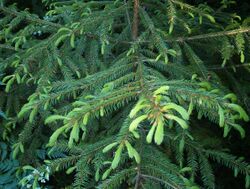Biology:Picea koraiensis
| Korean spruce | |
|---|---|

| |
| Young Korean spruce | |
| Scientific classification | |
| Kingdom: | Plantae |
| Clade: | Tracheophytes |
| Clade: | Gymnospermae |
| Division: | Pinophyta |
| Class: | Pinopsida |
| Order: | Pinales |
| Family: | Pinaceae |
| Genus: | Picea |
| Species: | P. koraiensis
|
| Binomial name | |
| Picea koraiensis Nakai[2]
| |
Picea koraiensis, the Korean spruce,[3] is a species of spruce.
It is a medium-sized evergreen tree growing to 30 m tall, and with a trunk diameter of up to 0.8 m. The shoots are orange-brown, glabrous or with scattered pubescence. The leaves are needle-like, 12–22 mm long, rhombic in cross-section, dark bluish-green with conspicuous stomatal lines. The cones are cylindric-conic, 4–8 cm long and 2 cm broad, maturing pale brown 5–7 months after pollination, and have stiff, smoothly rounded scales.
Its population is stable though low, and there are no known protocols that protect it. It is found mostly in the northern Korean Peninsula near the Yalu River, and in Siberia near the Ussuri River. In China it is restricted north-eastern provinces Heilongjiang, Jilin, and Liaoning. It is also believed that it might possibly occur in areas in southern Ussuriland.
It is closely related to Koyama's spruce (Picea koyamae), and treated as synonymous with it by some botanists.
References
- ↑ Thomas, P.; Zhang, D.; Katsuki, T.; Rushforth, K. (2013). "Picea koraiensis". IUCN Red List of Threatened Species 2013: e.T42326A2972747. doi:10.2305/IUCN.UK.2013-1.RLTS.T42326A2972747.en. https://www.iucnredlist.org/species/42326/2972747. Retrieved 12 November 2021.
- ↑ Conifer Specialist Group (1998). "Picea koraiensis". IUCN Red List of Threatened Species 1998. https://www.iucnredlist.org/details/42326/0. Retrieved 16 March 2013.
- ↑ English Names for Korean Native Plants. Pocheon: Korea National Arboretum. 2015. pp. 572. ISBN 978-89-97450-98-5. http://www.forest.go.kr/kna/special/download/English_Names_for_Korean_Native_Plants.pdf. Retrieved 24 December 2016.
External links
Wikidata ☰ Q2368526 entry
 |


